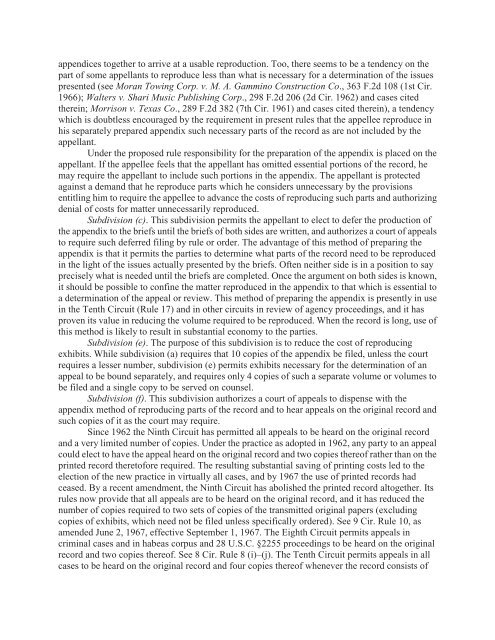Federal Rules of Appellate Procedure 2014-2015, 2014a
Federal Rules of Appellate Procedure 2014-2015, 2014a
Federal Rules of Appellate Procedure 2014-2015, 2014a
You also want an ePaper? Increase the reach of your titles
YUMPU automatically turns print PDFs into web optimized ePapers that Google loves.
appendices together to arrive at a usable reproduction. Too, there seems to be a tendency on the<br />
part <strong>of</strong> some appellants to reproduce less than what is necessary for a determination <strong>of</strong> the issues<br />
presented (see Moran Towing Corp. v. M. A. Gammino Construction Co., 363 F.2d 108 (1st Cir.<br />
1966); Walters v. Shari Music Publishing Corp., 298 F.2d 206 (2d Cir. 1962) and cases cited<br />
therein; Morrison v. Texas Co., 289 F.2d 382 (7th Cir. 1961) and cases cited therein), a tendency<br />
which is doubtless encouraged by the requirement in present rules that the appellee reproduce in<br />
his separately prepared appendix such necessary parts <strong>of</strong> the record as are not included by the<br />
appellant.<br />
Under the proposed rule responsibility for the preparation <strong>of</strong> the appendix is placed on the<br />
appellant. If the appellee feels that the appellant has omitted essential portions <strong>of</strong> the record, he<br />
may require the appellant to include such portions in the appendix. The appellant is protected<br />
against a demand that he reproduce parts which he considers unnecessary by the provisions<br />
entitling him to require the appellee to advance the costs <strong>of</strong> reproducing such parts and authorizing<br />
denial <strong>of</strong> costs for matter unnecessarily reproduced.<br />
Subdivision (c). This subdivision permits the appellant to elect to defer the production <strong>of</strong><br />
the appendix to the briefs until the briefs <strong>of</strong> both sides are written, and authorizes a court <strong>of</strong> appeals<br />
to require such deferred filing by rule or order. The advantage <strong>of</strong> this method <strong>of</strong> preparing the<br />
appendix is that it permits the parties to determine what parts <strong>of</strong> the record need to be reproduced<br />
in the light <strong>of</strong> the issues actually presented by the briefs. Often neither side is in a position to say<br />
precisely what is needed until the briefs are completed. Once the argument on both sides is known,<br />
it should be possible to confine the matter reproduced in the appendix to that which is essential to<br />
a determination <strong>of</strong> the appeal or review. This method <strong>of</strong> preparing the appendix is presently in use<br />
in the Tenth Circuit (Rule 17) and in other circuits in review <strong>of</strong> agency proceedings, and it has<br />
proven its value in reducing the volume required to be reproduced. When the record is long, use <strong>of</strong><br />
this method is likely to result in substantial economy to the parties.<br />
Subdivision (e). The purpose <strong>of</strong> this subdivision is to reduce the cost <strong>of</strong> reproducing<br />
exhibits. While subdivision (a) requires that 10 copies <strong>of</strong> the appendix be filed, unless the court<br />
requires a lesser number, subdivision (e) permits exhibits necessary for the determination <strong>of</strong> an<br />
appeal to be bound separately, and requires only 4 copies <strong>of</strong> such a separate volume or volumes to<br />
be filed and a single copy to be served on counsel.<br />
Subdivision (f). This subdivision authorizes a court <strong>of</strong> appeals to dispense with the<br />
appendix method <strong>of</strong> reproducing parts <strong>of</strong> the record and to hear appeals on the original record and<br />
such copies <strong>of</strong> it as the court may require.<br />
Since 1962 the Ninth Circuit has permitted all appeals to be heard on the original record<br />
and a very limited number <strong>of</strong> copies. Under the practice as adopted in 1962, any party to an appeal<br />
could elect to have the appeal heard on the original record and two copies there<strong>of</strong> rather than on the<br />
printed record theret<strong>of</strong>ore required. The resulting substantial saving <strong>of</strong> printing costs led to the<br />
election <strong>of</strong> the new practice in virtually all cases, and by 1967 the use <strong>of</strong> printed records had<br />
ceased. By a recent amendment, the Ninth Circuit has abolished the printed record altogether. Its<br />
rules now provide that all appeals are to be heard on the original record, and it has reduced the<br />
number <strong>of</strong> copies required to two sets <strong>of</strong> copies <strong>of</strong> the transmitted original papers (excluding<br />
copies <strong>of</strong> exhibits, which need not be filed unless specifically ordered). See 9 Cir. Rule 10, as<br />
amended June 2, 1967, effective September 1, 1967. The Eighth Circuit permits appeals in<br />
criminal cases and in habeas corpus and 28 U.S.C. §2255 proceedings to be heard on the original<br />
record and two copies there<strong>of</strong>. See 8 Cir. Rule 8 (i)–(j). The Tenth Circuit permits appeals in all<br />
cases to be heard on the original record and four copies there<strong>of</strong> whenever the record consists <strong>of</strong>


















